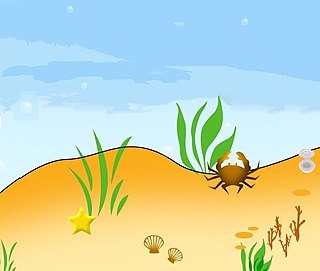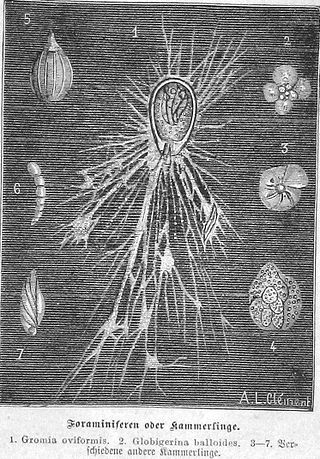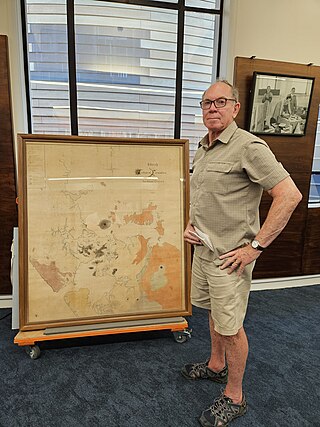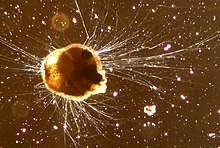
Meiobenthos, also called meiofauna, are small benthic invertebrates that live in marine or freshwater environments, or both. The term meiofauna loosely defines a group of organisms by their size—larger than microfauna but smaller than macrofauna—rather than by their taxonomy. This fauna includes both animals that turn into macrofauna later in life, and those small enough to belong to the meiobenthos their entire life. In marine environments there can be thousands of individuals in 10 cubic centimeters of sediment, and counts animals like nematodes, copepods, rotifers, tardigrades and ostracods, but protists like ciliates and foraminifers within the size range of the meiobethos are also often included. In practice, the term usually includes organisms that can pass through a 1 mm mesh but are retained by a 45 μm mesh, though exact dimensions may vary. Whether an organism will pass through a 1 mm mesh also depends upon whether it is alive or dead at the time of sorting.

Xenophyophorea is a clade of foraminiferans. Xenophyophores are multinucleate unicellular organisms found on the ocean floor throughout the world's oceans, at depths of 500 to 10,600 metres. They are a kind of foraminiferan that extract minerals from their surroundings and use them to form an exoskeleton known as a test.

Foraminifera are single-celled organisms, members of a phylum or class of Rhizarian protists characterized by streaming granular ectoplasm for catching food and other uses; and commonly an external shell of diverse forms and materials. Tests of chitin are believed to be the most primitive type. Most foraminifera are marine, the majority of which live on or within the seafloor sediment, while a smaller number float in the water column at various depths, which belong to the suborder Globigerinina. Fewer are known from freshwater or brackish conditions, and some very few (nonaquatic) soil species have been identified through molecular analysis of small subunit ribosomal DNA.

The Rhizaria are a diverse and species-rich supergroup of mostly unicellular eukaryotes. Except for the Chlorarachniophytes and three species in the genus Paulinella in the phylum Cercozoa, they are all non-photosynthethic, but many foraminifera and radiolaria have a symbiotic relationship with unicellular algae. A multicellular form, Guttulinopsis vulgaris, a cellular slime mold, has been described. This group was used by Cavalier-Smith in 2002, although the term "Rhizaria" had been long used for clades within the currently recognized taxon.

Gromia is a genus of protists, closely related to foraminifera, which inhabit marine and freshwater environments. It is the only genus of the family Gromiidae. Gromia are ameboid, producing filose pseudopodia that extend out from the cell's proteinaceous test through a gap enclosed by the cell's oral capsule. The test, a shell made up of protein that encloses the cytoplasm, is made up of several layers of membrane, which resemble honeycombs in shape – a defining character of this genus.

The Rotaliida are an order of Foraminifera, characterized by multilocular tests (shells) composed of bilamellar perforate hyaline lamellar calcite that may be optically radial or granular.
Carterina is a genus in the family Trochamminidae, composing its own subfamily Carterininae. The genus is described from specimens gathered during the Challenger expedition's circumnavigation of the Earth from 1872-1876.

Carterinida is an order of multi-chambered foraminifera within the Globothalamea. Members of this order form hard tests out of thin calcite rods known as spicules, which are held together by a proteinaceous matrix. As of August 2023, the order contains a single family, Carterinidae.
Elphidium williamsoni is a species of foraminiferans belonging to the family Elphidiidae. Elphidium williamsoni is found in abundance around the coasts of the UK, predominantly in the lower end of the coast.
The Cassidulinacea is a superfamily of benthic amoeboid foraminifera in the order Rotaliida that has been extant from the Paleocene down to the present. Tests are composed of secreted, optically radial or granular, perforate calcite with chambers biserially coiled at least in the early part, Apertures are usually an interiomarginal slit, but may become terminal and may have secondary features.

Reticulomyxa is a monospecific genus of freshwater foraminiferans. The type species is the unicellular Reticulomyxa filosa. It is found in freshwater environments as well as moist environments, like decomposing matter and damp soils. The heterotrophic naked foraminiferan can feed on microbes as well has larger organisms and is able to be sustained in culture by supplemented nutrients such as wheat germ and oats. The large, multinucleate foraminferan is characteristic for its lack of test and named for the network of connecting pseudopodia surrounding its central body mass. The organism has unique bidirectional cytoplasmic streaming throughout the anastomosing pseudopodia that is some of the fastest reported organelle transport observed. Reticulomyxa was first described in 1949 and is commonly used as a model organism for the unique transport of organelles throughout the cytoplasm of pseudopodia by cytoskeletal mechanisms. Only asexual reproduction of this genus has been observed in culture, but the genome possesses genes related to meiosis suggesting it is capable of sexually reproductive life stages.
Ammonia tepida is a benthic foraminifer living in the sediment of brackish waters. It is very similar to Ammonia beccarii, but the latter lives on the surface of red algae. Once considered a globally widespread taxon, a recent genetic and morphological study has revealed that many of what were once considered members of A. tepida in fact represent other species of Ammonia, primarily Ammonia veneta, with true specimens of A. tepida only being found in Atlantic waters, off the coast of the Americas.
Globigerinoides is an extant genus of shallow-water planktonic foraminifera of family Globigerinidae. First appearing in the Oligocene these foraminifera are found in all modern oceans. Species of this genus occupy the euphotic zone, generally at depths between 10-50m, in waters which cover a range of salinities and temperatures. They are a shorter lived species, especially when compared to Globorotalia genus. As a genus Globigerinoides is widely used in various fields of research including biostratigraphy, isotope geochemistry, biogeochemistry, climatology, and oceanography.

Cyclammina is a genus of foraminifers in the family Cyclamminidae. Most species are extinct, but there are a few that are extant.

"Monothalamea" is a grouping of foraminiferans, traditionally consisting of all foraminifera with single-chambered tests. Recent work has shown that the grouping is paraphyletic, and as such does not constitute a natural group; nonetheless, the name "monothalamea" continues to be used by foraminifera workers out of convenience.

Many protists have protective shells or tests, usually made from silica (glass) or calcium carbonate (chalk). Protists are a diverse group of eukaryote organisms that are not plants, animals, or fungi. They are typically microscopic unicellular organisms that live in water or moist environments.

Bruce William Hayward is a New Zealand geologist, marine ecologist, and author. He is known as a leading expert on living and fossil foraminifera.

Foraminiferal tests are the tests of Foraminifera.

Christopher M. WadeFLS is an evolutionary biologist and parasitologist at the University of Nottingham. Wade is an elected Fellow of the Linnean Society and is currently a visiting professor at Chulalongkorn University (2010–Present).

Pulleniatina obliquiloculata is a planktonic foraminifera, one of the two extant species for the genus Pulleniatina, first occurrence within N19 zone. Widely tropical-subtropical marine plankton, pelagic inhabitants of deep waters.














